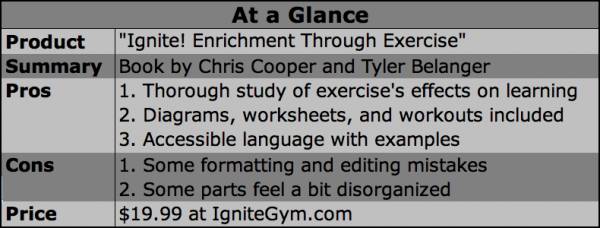
The book Ignite! Enrichment Through Exercise by Chris Cooper and Tyler Belanger, is packed with information, but it all boils down to a very simple concept: learning is an activity of the brain and the entire body. As the authors say, “Movement is hardwired into our system to trigger cognitive action.” Ignite! not only to exposes the science behind these assertions, but also outlines what an educational program that took the relation between the brain and movement would look like.
As the wife of a high school teacher and mother of a preschooler and toddler, I found this book fascinating. Belanger and Cooper have managed to compile a resource that is both packed with information and accessible. There is a lot of information in this book, but these are five concepts that I found make this book and its approach to learning stand out:
1. The Body Is Made To Move
Belanger and Cooper emphasize that the body should be in continuous motion. So often you hear trainers preach the “30 minutes of exercise per day” line. Not so for the authors of Ignite. “The body is built to move not only one hour per day, or four times a week, but to remain in constant action and reaction.” Imagine if we were to implement that concept in the modern school setting.
2. Setting the Stage For Success:
“For a student to reach a state of self-actualization – ready to learn, confident in their capacity, and in a positive state of mind – their most basic needs must be met first.” This seems obvious, but so often in my experience tutoring middle and high schoolers, the basics are forgotten. Sleep, stress, and diet play a critical role in academic and athletic success, and I was happy to see that the Ignite! curriculum acknowledges the role of these basic needs.
3. Centrality of Play:
“Play is a form of therapy AND a form of practice.” Belanger and Cooper use the example of Alice, a 12-year-old with a brain injury. After several unsuccessful sessions ignoring her therapists and even hiding under the table to avoid therapy, Alice tried the Ignite! program. “Ignite! was playtime to Alice; it was practice. It was a chance to challenge her abilities and improve.”
4. Creating a Context For Learning:
Learning doesn’t have to take place in a sterile classroom. One unique aspect of the Ignite curriculum is that all lessons are connected to some kind of physical activity. For example, the lesson might begin with a warm up to release dopamine and acetylcholine and increase the heart rate, followed by the lesson introduction, and finally moving into a focus drill. The session ends with an Anchoring Activity to make sure the information sticks.
5. Movement as a Critical Part of Learning:
We seem to remember this during early childhood, but as children get older, they move less and less in many classroom settings. The Ignite! program aims to utilize movement to anchor thoughts and encourage creative thinking.
If these are the types of ideas you enjoy discussing with fellow teachers or coaches, check out this book. I’ve only scraped the surface of the information you will find in Ignite!. Here’s a brief overview of the book’s sections:
- Anatomy or Better Living Through Chemistry: Explores how exercise affects the brain and primes it for learning.
- Childhood Development: Explores the brain’s development from infancy, and how this relates to learning, social development, and movement patterns.
- Ignite! In Practice and Delivery: Explores the plasticity of the brain and the centrality of practice
- Applying Ignite! In a One-On-One Setting At Home, Or With a Coach: Provides some concrete tips for using the Ignite! approach in an educational or home one-on-one setting
- Ignite! Program Delivery in the Classroom: Offers a brief comparison of Ignite!with the traditional classroom model and gives tips for teachers.
- Resource Section: Various studies and an article from the CrossFit Journal
- The Ignite! Academy: Provides a detailed picture of what an Ignite! academy looks like, from the actual layout of the academy to the lesson plans presented.
The book also includes several appendices with worksheets, workout progressions, and more.
To my mind, the only problem with this book was the formatting. There’s not index or table of contents, and I found typos in several spots. However, the wealth of information definitely makes up for less-than-perfect formatting. I’d love to hear what other coaches and educators thought of Ignite!,or any success stories from this innovative program. Feel free to share in the comments section below!






